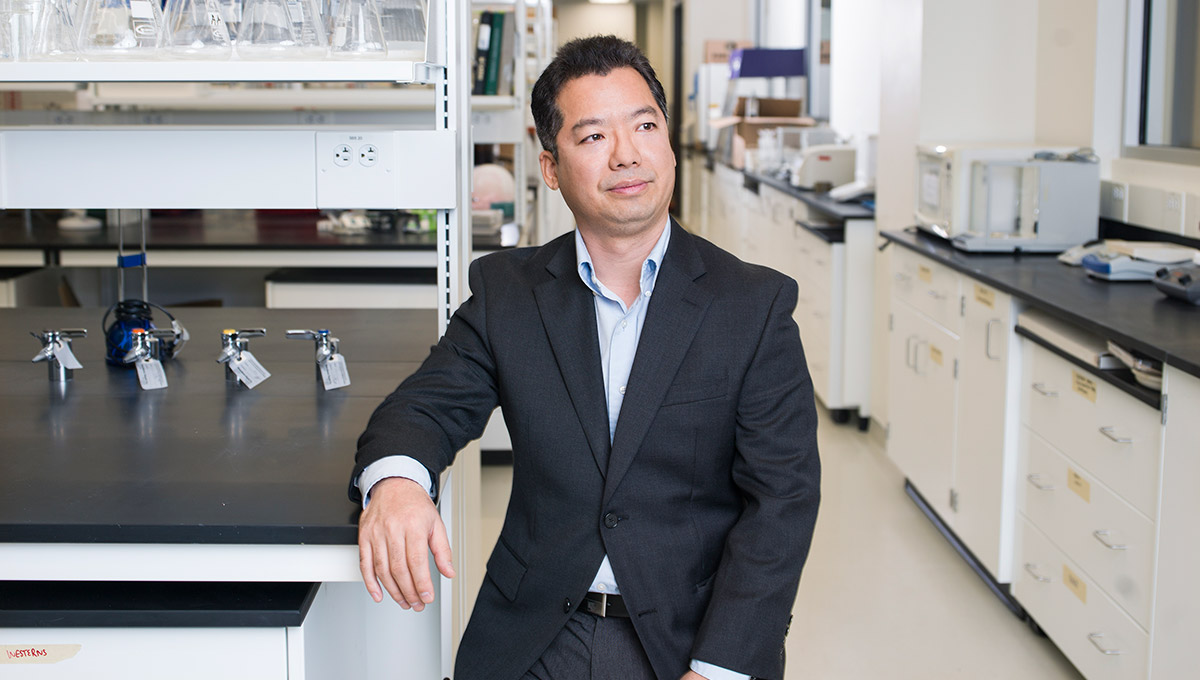By Tyrone Burke
Photos by Chris Roussakis
A child’s brain is plastic. Just as a fluid polymer can be moulded to take any shape, the human brain changes to meet different developmental needs as a child matures.
Or at least it’s supposed to.
Neuroplasticity – a process in which the brain reorganizes its networks of neurons — is deeply impacted by interaction with our environment. The brain’s ability to make these adaptations is at its peak in infancy. As babies rapidly acquire language, communication and memory-dependent skills, the way their neurons communicate with each other changes to optimize learning.
But when infants suffer seizures during critical periods of development, their brain chemistry can be permanently altered, impacting how neurons are able to organize themselves over the long term.
It’s a lasting impairment that may be a root cause of some cases of autism and intellectual disability.
“It’s a double-edged sword,” says Carleton University’s Hongyu Sun, an assistant professor in the Department of Neuroscience. “The brain’s high level of plasticity may increase its susceptibility to adverse neurological experiences like seizures.”
Sun’s five-year, $2.5 million Canada Research Chair in Developmental Neuroscience is seeking a better understanding of how seizures impact brain development during the first weeks of life.

Preventing the Onset of Neurological Disorders
Through a series of behavioural tests, he will explore effects on cognitive ability, but the project goes further than that. It will explore how light waves could bring irregular patterns of brain activity back to normal, possibly preventing the onset of common neurological disorders.
Seizures are abrupt surges of electrical activity in the brain, with synapses firing at extreme rates. Infants who suffer them develop intellectual disabilities at more than 10 times the normal rate.
More than a third of children with autism had seizures as infants.
Neuroscientists have long assumed that most neurons in seizure-affected areas of the brain fire simultaneously – and research methods have reflected this, typically analyzing random samples.
Sun’s lab has shown that a specific group of neurons in the hippocampus – a region of the brain that forms memories of experienced events — become hyper-excited after seizures in the first weeks of life. His new research will zero in on those neurons to better understand what is occurring to them.
He hypothesizes that the process of synaptogenesis – the creation of networks that enable neurons to transmit signals – is disrupted, and that the effects are long-lasting.
Some brain development occurs regardless of a child’s interaction with their environment, but other development depends on sensory experiences. Known as activity–dependent development, it is this that Sun believes seizures impair.
“I’ve been amazed by the power of the immature brain since my early academic career,” he says. “During early life, the brain can create up to 1,000 neural connections in a second through an experience dependent manner. Seizures affect optimal brain function for the rest of life.”
Sun is seeking to nip this problem in the bud.
People with autism spectrum disorders have high concentrations of glutamate — an amino acid that is excitatory, meaning it transmits signals the brain can transform into actions — in parts of their hippocampus. Sun hypothesizes that this overabundance begins with increased glutamate transmissions caused by seizures in newborns.

Interference Caused by Information Overload
The lasting excitation affects other neurons that receive these excess glutamate neurotransmissions. The interference caused by the information overload limits the brain’s ability to adapt to perform key developmental tasks. Some neurons aren’t able to organize themselves in ways that development demands. Others never activate at all. The excess glutamate could be the root cause of their failure to launch.
These circumstances may contribute to conditions like autism and intellectual disability taking root, but optogenetic suppression could reduce the damage they do.
Optogenetics are a precise research tool that engineers neurons to be susceptible to certain spectra of light. Neurons impacted by infants’ seizures will be given a virus that makes it possible to inhibit their activity using yellow light.
Sun believes this can bring brain activity back into the normal range, halting the cascading effects that originate with the neurons’ excess glutamate transmissions.
If the activity can be silenced, the implications would be profound. It could lead to research into how optogenetic suppression could be used in clinical settings to intervene before conditions like autism and intellectual disabilities take hold.
It could lead to treatments that prevent common neurological disorders that, for the time being, are a life sentence.
Friday, January 5, 2018 in Faculty of Science, Research
Share: Twitter, Facebook



